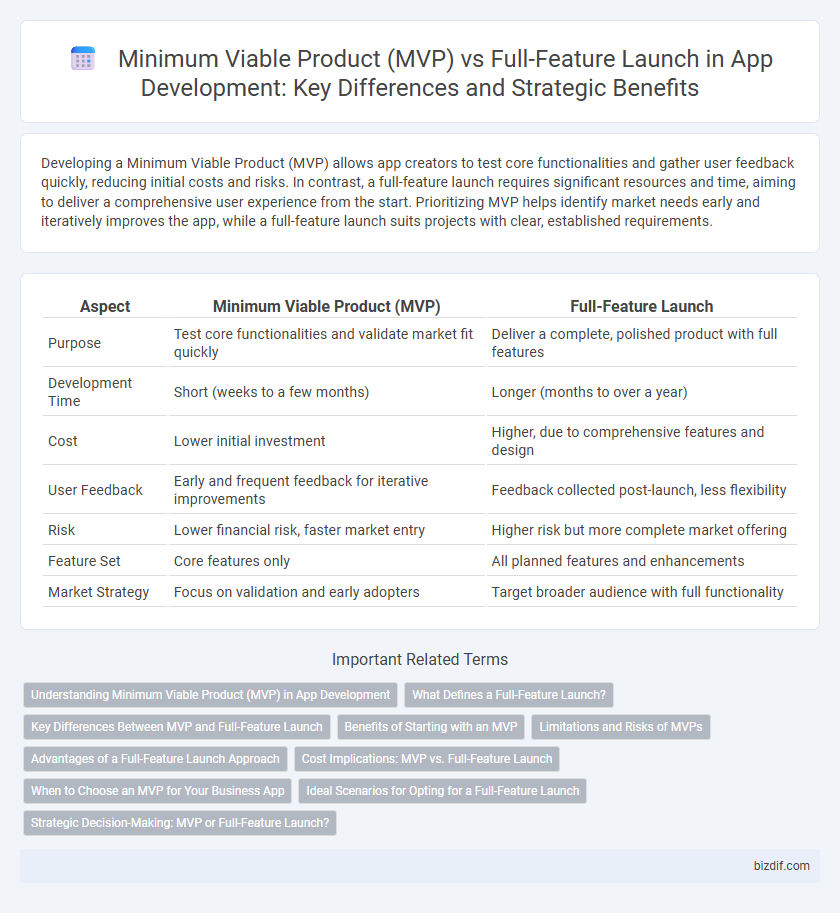Developing a Minimum Viable Product (MVP) allows app creators to test core functionalities and gather user feedback quickly, reducing initial costs and risks. In contrast, a full-feature launch requires significant resources and time, aiming to deliver a comprehensive user experience from the start. Prioritizing MVP helps identify market needs early and iteratively improves the app, while a full-feature launch suits projects with clear, established requirements.
Table of Comparison
| Aspect | Minimum Viable Product (MVP) | Full-Feature Launch |
|---|---|---|
| Purpose | Test core functionalities and validate market fit quickly | Deliver a complete, polished product with full features |
| Development Time | Short (weeks to a few months) | Longer (months to over a year) |
| Cost | Lower initial investment | Higher, due to comprehensive features and design |
| User Feedback | Early and frequent feedback for iterative improvements | Feedback collected post-launch, less flexibility |
| Risk | Lower financial risk, faster market entry | Higher risk but more complete market offering |
| Feature Set | Core features only | All planned features and enhancements |
| Market Strategy | Focus on validation and early adopters | Target broader audience with full functionality |
Understanding Minimum Viable Product (MVP) in App Development
Minimum Viable Product (MVP) in app development refers to a version of the application containing only the core features necessary to solve the primary user problem and gather early feedback. This approach enables developers to test assumptions, validate market demand, and iterate quickly while minimizing development costs and risks. Prioritizing MVP helps align product development with user needs, accelerating time-to-market and optimizing resource allocation.
What Defines a Full-Feature Launch?
A Full-Feature Launch in app development refers to releasing a product with comprehensive functionality that addresses all core user needs and includes advanced features beyond the essentials. This launch stage emphasizes robust performance, scalability, and seamless user experience through thorough testing and quality assurance. Unlike an MVP, a Full-Feature Launch aims for market readiness with polished design, complete integrations, and extensive support options.
Key Differences Between MVP and Full-Feature Launch
Minimum Viable Product (MVP) focuses on launching with core features to validate market demand and gather user feedback quickly, minimizing development time and costs. Full-Feature Launch includes comprehensive functionalities designed to offer a complete user experience, often requiring extensive development, testing, and resources. The key differences lie in scope, speed to market, risk management, and customer validation strategy within app development cycles.
Benefits of Starting with an MVP
Starting with a Minimum Viable Product (MVP) enables app developers to validate core functionalities quickly, reducing time-to-market and development costs. MVPs facilitate gathering real user feedback, allowing iterative improvements that align with customer needs and market demands. This approach minimizes risks compared to a full-feature launch by focusing on essential features, enhancing product-market fit before scaling.
Limitations and Risks of MVPs
Minimum Viable Products (MVPs) often face limitations such as reduced functionality, which can lead to poor user experience and inaccurate market validation. Risks include potential damage to brand reputation if initial releases contain bugs or lack critical features, deterring early adopters. Narrow feature sets may also result in insufficient data collection, hindering effective iteration and product improvement.
Advantages of a Full-Feature Launch Approach
A full-feature launch offers a comprehensive user experience by delivering all planned functionalities from the start, which can enhance customer satisfaction and retention. This approach provides immediate competitive advantage and brand credibility by showcasing a polished, market-ready product. Investing upfront in a full-feature app reduces the risk of fragmented development and costly iterative updates, streamlining long-term maintenance and scalability.
Cost Implications: MVP vs. Full-Feature Launch
Choosing a Minimum Viable Product (MVP) significantly reduces initial development costs by focusing on core functionalities needed to validate market demand. In contrast, a Full-Feature Launch demands higher upfront investment due to extensive design, development, and testing of comprehensive features. Businesses opting for MVP save on operational expenses and shorten time-to-market, minimizing financial risk before scaling with additional features.
When to Choose an MVP for Your Business App
Choosing an MVP for your business app is ideal when you need to validate market demand quickly and minimize initial development costs. MVPs allow you to gather user feedback and iterate rapidly, reducing the risk of building unwanted features. This approach suits startups and businesses entering new markets where agility and learning outweigh comprehensive functionality.
Ideal Scenarios for Opting for a Full-Feature Launch
A Full-Feature Launch is ideal for apps targeting established markets with clear user demands and competitive pressures, where delivering comprehensive functionality upfront can enhance user acquisition and retention. This approach suits well-funded projects or enterprises with robust resources for development, testing, and marketing to ensure a polished, bug-free experience from day one. Launching fully-featured apps can also benefit products requiring complex integrations or regulatory compliance that cannot be efficiently addressed through iterative MVP releases.
Strategic Decision-Making: MVP or Full-Feature Launch?
Choosing between a Minimum Viable Product (MVP) and a full-feature launch hinges on strategic decision-making that balances time-to-market, user feedback integration, and resource allocation. MVPs enable rapid validation of core functionalities, minimizing development costs and reducing risks by prioritizing essential features to attract early adopters. Full-feature launches demand extensive upfront investment and longer development timelines but can deliver a comprehensive user experience that may strengthen initial market impact and brand positioning.
Minimum Viable Product (MVP) vs Full-Feature Launch Infographic

 bizdif.com
bizdif.com